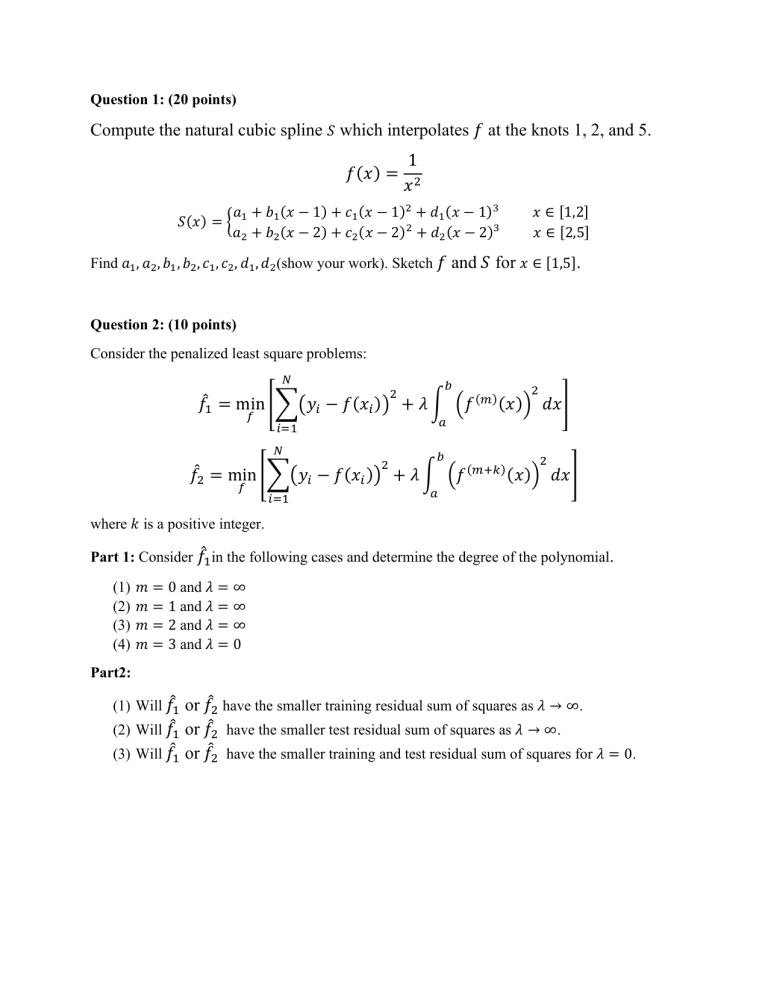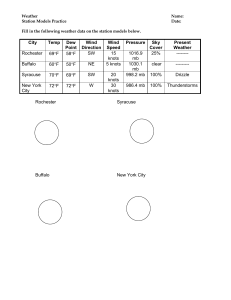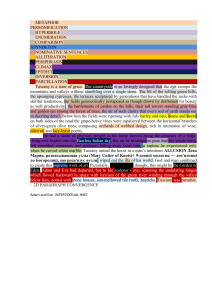
Question 1: (20 points)
Compute the natural cubic spline 𝑆 which interpolates 𝑓 at the knots 1, 2, and 5.
𝑓(𝑥) =
𝑆(𝑥) = {
1
𝑥2
𝑎1 + 𝑏1 (𝑥 − 1) + 𝑐1 (𝑥 − 1)2 + 𝑑1 (𝑥 − 1)3
𝑎2 + 𝑏2 (𝑥 − 2) + 𝑐2 (𝑥 − 2)2 + 𝑑2 (𝑥 − 2)3
𝑥 ∈ [1,2]
𝑥 ∈ [2,5]
Find 𝑎1 , 𝑎2 , 𝑏1 , 𝑏2 , 𝑐1 , 𝑐2 , 𝑑1 , 𝑑2(show your work). Sketch 𝑓 and 𝑆 for 𝑥 ∈ [1,5].
Question 2: (10 points)
Consider the penalized least square problems:
𝑁
𝑏
2
2
𝑓̂1 = min [∑(𝑦𝑖 − 𝑓(𝑥𝑖 )) + 𝜆 ∫ (𝑓 (𝑚) (𝑥)) 𝑑𝑥 ]
𝑓
𝑎
𝑖=1
𝑁
2
𝑏
2
𝑓̂2 = min [∑(𝑦𝑖 − 𝑓(𝑥𝑖 )) + 𝜆 ∫ (𝑓 (𝑚+𝑘) (𝑥)) 𝑑𝑥 ]
𝑓
𝑖=1
𝑎
where 𝑘 is a positive integer.
Part 1: Consider 𝑓̂1 in the following cases and determine the degree of the polynomial.
(1)
(2)
(3)
(4)
𝑚 = 0 and 𝜆 = ∞
𝑚 = 1 and 𝜆 = ∞
𝑚 = 2 and 𝜆 = ∞
𝑚 = 3 and 𝜆 = 0
Part2:
(1) Will 𝑓̂1 or 𝑓̂2 have the smaller training residual sum of squares as 𝜆 → ∞.
(2) Will 𝑓̂1 or 𝑓̂2 have the smaller test residual sum of squares as 𝜆 → ∞.
(3) Will 𝑓̂1 or 𝑓̂2 have the smaller training and test residual sum of squares for 𝜆 = 0.
Question 3: (40 points)
In precision farming and agriculture practices, soil fertility is an important factor which affects
plant growth and maintaining soil health. To determine soil quality and fertility in a short time and
without complicated sample preparations, near infrared reflectance spectroscopy (NIRS) is
employed. “Question3.csv” contains NIRS of 40 bulk soil samples. Calculate the mean function
of the data (figure below) and use the following methods to estimate it.
(a) Cubic Spline: vary the number of knots from 5 to 50 and use 5-fold cross validation to
determine the optimal number of knots. Report the optimal number of knots and the cross
validation MSE.
(b) Cubic B-splines: vary the number of knots from 5 to 50 and use 5-fold cross validation to
determine the optimal number of knots. Report the optimal number of knots and the cross
validation MSE.
(c) Smoothing Spline: Report the optimal lambda and MSE.
(d) Gaussian kernel: use 5-fold cross validation to determine the optimal kernel bandwidth.
Report the optimal bandwidth and the cross validation MSE.
Plot your estimated curves along with the mean function of NIR spectra of the soil samples.
Question 4: (30 points)
Olive oil is cultivated extensively across the Mediterranean basin. It is known that the composition
of olive oils varies with geographic origin due to a number of different factors: regional differences
in climate, soil, and agricultural practice. Verifying the declared origin, or determining the origin
of an unidentified olive oil, is, therefore, a challenging problem. In this question our goal is to
distinguish extra virgin olive oils from different producing countries. “Question4.csv” dataset
contains 60 authenticated samples of extra virgin olive oils, originating from four European
producing countries: Greece, Italy, Portugal, and Spain. Use the first 30 data samples for training;
and the rest to evaluate the accuracy of your models. The last column of the dataset indicates
classes {1, 2, 3, 4}.
Group
Designation
1
2
3
4
Total
Country of Origin
Greece
Italy
Portugal
Spain
Number of
Samples
10
17
8
25
60
Part 1: In this part, we use cubic B-splines with 70 knots for dimension reduction and feature
extraction. Use the extracted features (B-spline coefficients) to build a multi-class support vector
machine (SVM). Evaluate the performance of your classifier on the test set.
-
Report the accuracy and confusion matrix.
Part 2: In this part, we use functional PCA for dimension reduction and feature extraction. Build
four multi-class SVMs using 2, 5, 8, and 10 harmonics. Evaluate the performance of your
classifiers on the test set.
-
Report the accuracy and confusion matrix of the four classifiers.


